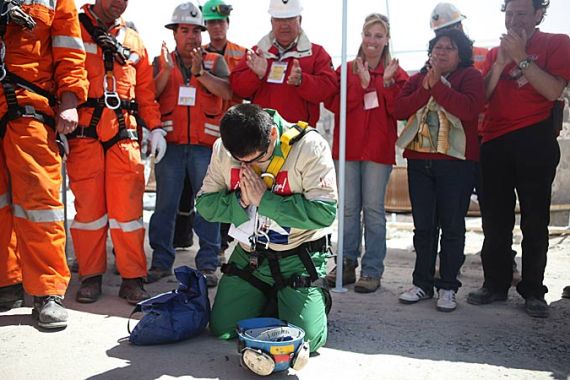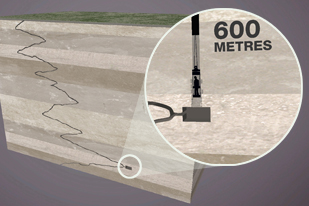Chile mine rescue under way
Thirty two of 33 trapped men lifted to safety and greeted by families as rescue operation continues at collapsed mine.

After more than two months underground, 32 of 33 miners have now emerged from the collapsed Chilean copper mine in the Atacama desert to the excitement and relief of waiting family and friends.
Rescue teams are lifting the miners to the surface one by one in a narrow, missile-like capsule, nicknamed Phoenix.
Each miner stepping out of the capsule is being greeted by up to three family members – and President Sebastian Pinera – before being seen by waiting doctors and flown to a triage centre for at least two days of check-ups.
| In depth | |||||||||
|
The 32nd and latest man to be rescued was Ariel Ticona, 29, whose wife gave birth to his daughter on September 14. Ticona reportedly watched her birth via remote video, and she was named Esperanza, the Spanish word for hope.
Mario Gomez, the oldest member in the group at 63, was pulled out safely after being fitted with a special mask to combat his breathing problems.
Describing his ascent, Gomez said: “It was very smooth, I didn’t feel anything.”
“He’s [Gomez] a very, very experienced miner,” Al Jazeera’s Lucia Newman, reporting from the mine, said.
“He began mining when he was 12 years old. He was one of those with the strongest will to survive we’ve been told.
“With his long experience, he was able to tell the younger ones to remain calm and to have faith they would be rescued.”
The 32 Chileans and one Bolivian trapped in the San Jose mine in northern Chile were initially believed to have perished, but they had found refuge in an emergency shelter and survived by strictly rationing their food and water.
On Wednesday, Evo Morales, the Bolivian president, visited Carlos Mamani, his rescued compatriot, at the triage centre.
‘All healthy’
Officials have decided the order in which the miners are being pulled up, based on their health and capacities.
The first miner to be rescued was Florencio Avalos, a 31-year-old driver, chosen because he was considered among the most physically and mentally fit of the group.
He smiled broadly as he emerged and hugged his weeping seven-year-old son and wife. He then embraced Sebastian Pinera, the president, who has been at the scene overseeing the rescue operation.
Mario Sepulveda, a 39-year-old electrical specialist, was the second to reach the surface.
After hugging his wife, he jubilantly handed souvenir rocks to laughing rescuers.
“I’m so happy!” Sepulveda yelled, punching his fist in the air and hugging everyone in sight.
The miners are being pulled up through a 600m-deep shaft in a rescue capsule wide as the shoulders of an average built miner, designed specifically for the operation.
The miners can communicate with rescue teams using an intercom in the capsule.
Newman said it took only 16 minutes for Avalos to be pulled up the shaft.
“Initially we had been told by authorities it would take about an hour for the journey from the bottom of the mine to the surface,” she said.
“But it’s been much, much quicker which means this whole operation could be finished within a day rather than the 48 hours initially announced.”
Avalos began his journey after a mining rescue expert and and a paramedic were lowered down the rescue tunnel to prepare the miners for their rescue.
Five rescuers are now down the shaft with the remaining miners.
‘Hundreds of contingencies’
The operation has been followed minute by minute by international media and Chilean citizens. More than 800 journalists and cameramen have gathered at the site.
The only media allowed to record the men coming out of the shaft is a government photographer and Chile’s state TV channel, whose live broadcast was delayed by 30 seconds or more to prevent the release of anything unexpected.
Panic attacks are the rescuers’ biggest concern. A miner could get claustrophobic and do something to damage the capsule. Or a falling rock could wedge it in the shaft.
Laurence Golborne, the Chilean mining minister, said authorities had already thought of everything.
“There is no need to try to start guessing what could go wrong. We have done that job,” he said. “We have hundreds of different contingencies.”
Our correspondent said the successful rescue operation is good news for Pinera, whose government has been criticised for its slow response to the earthquake which killed more than 500 people in February.
“Pinera has been under quite a bit of criticism for the slowness of the reconstruction effort,” Newman said.
“[The mine rescue] has taken away some of the attention from that. Most of the eyes of the country have been focused on this rescue effort but once it’s over, people will go back to asking the hard questions.
“Not only what happened in the mine and what’s wrong with the mining regulations in Chile but also what about the rest of the country?”
Media opportunities
The miners are reported to have moved to stop any individual from profiting at the expense of the group, drawing up a legal contract to share any profits from the story of their experience.
Speaking to Al Jazeera, Stuart Higgins, a former UK tabloid newspaper editor, said: “The media opportunities in terms of films, books, tv specials, will be absolutely unlimited.
“And of course with 33 men, as with any large group of people, there’s going to be dipsutes, there’s going to be things that have gone on down underground that we don’t know about.
“One of the big issues is going to be, for the media, is the first person out of the blocks of course. If one person tells their story is that going to be much different from the other 32 stories.
“So there’s going to be a real kind of challenge to keep a unity amongst these men which has been absolutely crucial when they’ve been 2,000 feet underground.
“But now I think they’ll be a few rows, and a few disputes, and I think we are going to have a fascinating few months to come.”
Medical check-ups
In the nearby town of Copiapo, streets and plazas were filled with people blowing horns and singing songs as they watched events unfold on large plasma screens.
The last miner out will be Luis Urzua, the shift foreman whose leadership was credited for helping the men endure 17 days with no outside contact after the mine collapsed on August 5.
Initially, officials had thought it would take until Christmas to get the miners out, but the drilling of a rescue tunnel 622 metres deep to reach where the miners were trapped was completed last weekend.
Al Jazeera’s Monica Villamizar, reporting from the rescue scene, said: “Authorities have told us that after all the necessary medical tests have been made, and the check-ups complete, they are free to go with their families and they are free to talk with whoever they want.
 |
| Rescuers reinforced part of the 600 metre long escape shaft with steel piping |
Each of the trapped miners has been promised six months of psychological support by the Chilean government.
Speaking to Al Jazeera, Eugen Gaal, from the UK Society of Occupational Medicine, said: “It’s a life-changing experience for all of them and some of them will actually use it to change their lives and others will crumble.
“There’s a range of emotions I would expect them to go through.
“Feelings of panic, nightmares, anxiety, even physical symptoms are well known after traumatic events.
“Some individuals will be more prone to this than others and it’s the long-term support, the psychological support that has been assured to these miners, that will help them to possibly overcome these problems if they do occur.”
The men, who set a new record for the length of time workers have survived underground after a mining accident, have been doing exercises to keep their weight down for their ascent.
As they were pulled to the surface, a video camera in the escape capsule watched for panic attacks.
The miners’ pulse, skin temperature and respiration rate are constantly measured through a monitor around their abdomens.
To prevent blood clotting from the quick ascent, they took aspirin and wore compression socks.
Medics say some of the men are psychologically fragile and may struggle with stress for a long time after their rescue.

